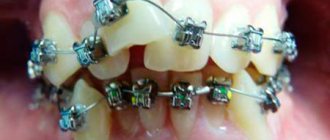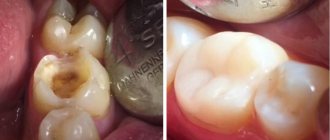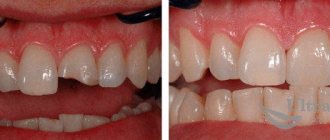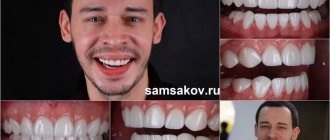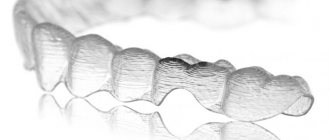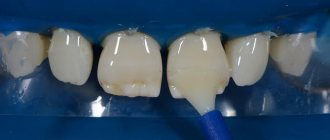From the name it is clear that dental restoration implies correction of appearance, correction of existing deficiencies. Especially often, such manipulation is carried out in case of minor damage to the enamel, for example, if caries is observed at the stain stage. However, improving the appearance of the smile area often requires more serious treatment when the destruction reaches superficial, medium and even deep caries. Dental restoration is a very delicate process that requires the use of high-quality materials and the doctor’s jewelry skills. These are the dentists who work at the VivaDent clinic. Adults and children come to us without fear, knowing that thanks to the use of the latest generation anesthetics and innovative means for prompt, high-quality and inexpensive dental restoration, pain is eliminated. We invite Muscovites and guests of the capital to see this in person at any of our branches!
Navigation
- Key recovery goals
- Types of dental restoration
- Advantages of composites
- Advantages of veneers
- Pros of lumineers
- Features of teeth extensions
- Materials used
- Prevention of destruction
Dental restoration – what is it anyway?
Artistic dental restoration allows you to restore the shape and basic functions of damaged teeth using filling materials. With the help of the dentist’s skill, it is possible to restore the natural whiteness of the smile, eliminate existing defects in the dentition and achieve high aesthetics of the teeth.
Artistic dental restoration is a unique technique for restoring minor defects in the crown of teeth, making them more aesthetically pleasing and making your smile as attractive as possible. For this purpose, modern dental materials are used that imitate dental tissues and give the teeth the desired external characteristics.
Refractor in dentistry - what is it?
In the usual production of veneers, doctors first create a wax model of the teeth, and then dental technicians use pressing or milling to create a solid veneer, the front surface of which imitates natural tooth enamel.
When using a refractor, a refractory base is first formed from a special material, and the dental technician applies ceramics to it in layers, forming a very thin plate. Then the entire structure is baked in an oven, after which it is handed over to the doctor so that the patient can try on the resulting veneer.
So, when answering the question “refractor veneers - what are they?” we can say that this is a very thin plate, in addition to the front surface of the tooth, slightly covering the side edges and the cutting edge. In fact, it is frameless and metal-free ceramics, the strength of which is imparted by a fire-resistant base.
Differences between veneers created using a refractor and conventional ones:
- strengthening teeth - after installation, the refractor plates are tightly connected to the surface of the tooth, which makes the structure very strong, almost monolithic, in contrast to pressed or milled plates, which remain rigid and non-plastic;
- increased strength - they are almost not susceptible to chipping or other damage, even if you like very hard food;
- minimal grinding due to minimal thickness - and sometimes you can even do without tooth preparation. Some clinics claim that they can make a ceramic veneer on a refractor with a thickness of 0.1–0.2 millimeters;
- almost no preparation is required - often it is enough to treat the enamel with a special compound and fix the veneers.
Prices for dental restoration in Moscow
Artistic restoration of teeth in Moscow is carried out in Vimontale. The method of tooth restoration is selected individually. When choosing the most suitable method, several factors are taken into account: the patient’s age, the nature of the enamel damage, general health, and the condition of the pulp. We offer the most affordable prices for dental restoration.
Aesthetic dentistry Price
Consultation with an orthopedic dentist, drawing up an orthopedic treatment plan 0 rub.
Anesthesia - application 100 rub.
Anesthesia - infiltration 400 rub.
Ceramic veneer E-MAX Up to 5 teeth 20,000 Promotion
Ceramic veneer E-MAX Over 8 teeth - 25% discount 15,000 20,000 rubles
Ceramic veneer E-MAX From 6 to 8 teeth - 15% discount 17,000 20,000 rubles
Aesthetic restoration 3,000 rub.
Production of a diagnostic model RUB 1,000.
Diagnostic model made of plaster 490 rub.
Diagnostic model made of class III-IV supergypsum 690 rub.
Polishing 1 tooth 90 rub.
Prevention of destruction
Nobody wants to visit the dental clinic one more time for dental restoration. However, statistics show that destruction of elements, ranging from caries at the spot stage to deep caries, is observed today in 75% of Russian residents. This is due to many factors. Smoking and alcohol, excessive consumption of carbonated drinks, sweets, natural and artificial dyes have a very negative effect. Of no small importance is genetic predisposition, as well as irregular oral care, which leads to the formation of plaque and tartar, which requires immediate dental restoration. But even after it’s done, you shouldn’t think that a charming smile will remain forever without any effort. Any patient can maintain an attractive appearance after dental restoration; you just need to listen to the doctor’s recommendations and regularly carry out simple preventive procedures. Dentists recommend:
- after restoration, extension, installation of veneers or lumineers, see a doctor at least once every six months;
- Be sure to brush your teeth twice a day, morning and evening; in the first 3 months after dental restoration, it is better to purchase a soft brush;
- subsequently it is necessary to use dental floss, or better yet, special brushes that do not cause damage to the gums;
- After each meal, use rinses without aggressive components; if they are absent, use ordinary, preferably boiled, water.
Simple precautions will help protect the elements restored during the dental restoration process. Crowns, composite materials, veneers and lumineers are effective ways to restore aesthetic and chewing functions, the choice of which remains with the specialist. The VivaDent clinic employs qualified doctors with higher education who spare no time in studying innovative trends. Dentistry is progressing by leaps and bounds, and it is gratifying that our company is a trendsetter in Russia today. Powerful medical equipment, the presence of our own laboratories in each branch, and the use of high-tech materials allow us to solve the most complex problems in the field of dental restoration. We even take on those cases that are refused in other places, because we are confident in our abilities. Our employees generously share their optimism with patients who know: visiting the VivaDent clinic for dental restoration will leave only positive emotions and give you the opportunity to smile dazzlingly!
In what cases is the dental restoration procedure used?
The procedure allows you to solve the following problems:
- carious damage to most of the frontal tooth surface;
- gaps between teeth;
- chips and damage to enamel;
- more than 50% destroyed crown;
- changes in enamel shade.
Aesthetic restoration provides an opportunity to correct the shape and color of teeth. After the procedure, they look natural and match the appearance and function of healthy teeth.
The cost of such a procedure depends on the nature of the defect and the methods used to eliminate it. This issue can be discussed at a clinic appointment.
How much does it cost to install a veneer on 1 tooth?
The price of a veneer per tooth depends on the material and the chosen clinic. The most inexpensive microprostheses are made of composite, but they are also short-lived. Ceramic and zirconium veneers are about the same price. Some professional clinics offer a “turnkey veneers” service, this will help avoid additional costs and risks. For your information, we offer a table with Moscow dentists where veneers can be installed.
| Dentistry | Website | Address | Composite veneer price | Price of ceramic veneer |
| ROOT Center | https://dentalroott.ru |
| from 15,000 rub. | from 37,000 rub. (all inclusive) |
| Implant Ru | https://www.implant.ru |
| — | from 36,000 rub. |
| City-Dent | https://city-dent.rf |
| from 7,000 rub. | from 15,000 rub. |
| The president | https://www.prezi-dent.ru |
| from 11,500 rub. | from 20,000 rub. |
| Center Family Dentistry | https://family-dental.ru |
| — | from 31,000 rub. |
Methods of aesthetic dental restoration
Methods for correcting imperfections in the shape, color and arrangement of elements of the dentition are usually divided into direct and indirect. In the first case, we are talking about a one-time visit to the dentist to restore aesthetics through the use of filling materials. Using photopolymers and composites, you can correct chips, cracks, scratches in enamel, discoloration, and also restore damaged crowns.
Indirect dental restoration involves correction using structures individually manufactured in the laboratory - crowns, veneers, inlays. This will require several visits to the dentist for preparation, taking an impression and fixing the finished structure.
Crowns are used if the tooth is destroyed by more than 50%. They use structures made of metal-ceramics and ceramics. They look natural, are durable and last 10–20 years.
Veneers are thin plates (0.5–0.7 mm) that make it possible to hide such defects: small gaps between the teeth of the frontal group, chips of the cutting part, discoloration of the enamel, unsightly shape of the dental unit. The designs are resistant to food coloring and retain their shine.
Dental restoration with inlays is applicable for significantly damaged teeth in the lateral chewing group. Microprostheses are made according to the shape of the defect and ideally restore the coronal part. The material is ceramics, whose properties and appearance are similar to natural dental tissues.
In Moscow, you can take advantage of direct and indirect dental restoration at the Vimontale clinic. We use advanced technologies and materials to restore the beauty and natural appearance of teeth. Sign up for a free consultation to find out which method of front teeth restoration is right for you and what the cost of the entire range of work is.
Our patients save money through promotions and discounts (check the website). We also cooperate with insurance companies.
The clinic's specialists make sure that your smile is beautiful and healthy!
Indications and contraindications for installation
Indications:
- Minor enamel defects - chips, cracks
- Pigmentation of the enamel layer that cannot be lightened
- Slightly crooked teeth
- Slight crowding of teeth in a row
- Unattractive shape of dental elements (or their small size)
- Enlarged interdental spaces (diastemas and trema)
- Increased abrasion of the enamel layer
Contraindications:
- Complex occlusion defects
- Diseases of teeth and gums (temporary ban)
- Severe destruction of the prosthetic element (more than 45%)
- Passion for hazardous sports (boxing, hockey)
- Bruxism
Note: if the patient is ready to wear a mouthguard every night at night, then veneers can be installed for bruxism.
Dental restoration methods: direct and indirect
Artistic restoration can be direct, in which the main manipulations are performed in the oral cavity, and indirect, when replacing structural defects are made in a dental laboratory and taking into account individual measurements and parameters. The specific option is selected by the patient with the help of the dentist. Indirect restoration is more aesthetically pleasing and durable, but is more expensive.
Direct restoration of teeth with composite material (filling)
The direct method of artistic restoration is carried out using high-quality composites that are resistant to stress, adverse thermal and chemical influences, and pathogenic microorganisms. The procedure is carried out in several stages.
Artistic restoration can restore the aesthetics of teeth that were previously depulped. To increase the reliability of restoration materials, a pin is installed in the root canal. This makes it possible to strengthen the composite material used and increase the service life of the restoration.
During dental restoration using composites, teeth are reliably isolated from high humidity and contact with the patient’s saliva using latex materials that have appropriate holes for the teeth. If the doctor does not pay due attention to this issue, then the service life of the filling material is sharply reduced and due to the loose fit of the filling to the tooth, caries may occur.
The dentist applies filling materials in layers that match the tone of the patient’s teeth. During this, a composite of different shades and degrees of transparency is used, thanks to which it is possible to obtain the most natural shade of tooth enamel. The final stage is the final correction of the shape of the teeth, grinding of excess areas and visible irregularities. The restoration becomes indistinguishable from natural tooth enamel.
Direct aesthetic restoration of teeth - advantages and disadvantages
The main advantage of direct restoration is the speed of correction of existing enamel defects. The procedure takes no more than 30-60 minutes and is completed in one visit to the dentist. The disadvantages include the relatively short period of time for preserving the aesthetics of the restoration: after 1.5-2 years, composite materials begin to turn yellow, as they absorb dyes coming from food and drinks.
Indirect restoration
Indirect artistic restoration involves the use of dental inlays and ceramic veneers. Modern ceramics can withstand intense chewing loads and at the same time look as natural as possible. With the help of such restorations, you can easily recreate the volume of damaged enamel and make unevenness and chips on the crown of your teeth invisible.
Artistic restoration is always recommended to be carried out after professional teeth cleaning, whitening and plaque removal. These preparatory measures help to slightly whiten the enamel and eliminate colonies of microbes that can provoke the development of infectious complications after restoration. Using a special scale, the dentist selects the most suitable color of materials that will be used to correct enamel defects.
Subsequently, the carious cavities are excised. If necessary, local anesthesia can be used. Old fillings that have lost their aesthetic appearance must be replaced. Restorative structures are made from individual impressions in a dental laboratory.
Veneers
Veneers are thin microprostheses. They are used in dental restoration to create an ideal smile. The plates are most often made from ceramics. Before installing them, it is necessary to grind down the tooth enamel a little. But composite veneers made from high-quality light-polymer materials are also in demand.
Aesthetic dental restoration with veneers - advantages and disadvantages
Properly carried out artistic restoration of teeth can eliminate all existing dental defects:
- change the tone of tooth enamel;
- correct the shape of the teeth and their position in the dentition;
- eliminate excessive gaps between teeth;
- restore the aesthetics of your smile.
Artistic restoration with veneers does not require pulp removal or significant grinding of enamel and is considered a fairly comfortable procedure. With its help, it is possible to keep teeth alive, as close to natural as possible.
The disadvantages include the relatively high cost of ceramic veneers. But the price corresponds to the materials used, technologies and the final result.
Materials used
The cost of dental restoration directly depends on the materials used. Extension on a pin involves implanting a rod made of titanium, steel or fiberglass into the bone tissue. The first material enjoys well-deserved popularity due to its unique combination of low weight, amazing strength, and environmental safety. The alloy, widespread in various areas of the national economy, integrates perfectly into the oral cavity without causing side effects. Surgical steel is an equally common material for dental restoration, characterized by high resistance to mechanical and thermal stress. As for fiberglass, recently the carbon variety of nanomaterial, which has the ability to adapt to the structure and behavior of the patient’s soft tissues and evenly distribute chewing loads, has become increasingly in demand. When restoring teeth using traditional methods using crowns, various materials are also used.
- Ceramics are an aesthetically beautiful solution that provides a snow-white smile and an attractive appearance. It requires careful care, is highly fragile and does not have a very long lifespan.
- Metal is an obsolete material that is currently almost never used. However, in terms of strength characteristics it surpasses its competitors, so products made from alloys are still in demand.
- Metal-ceramics is an intermediate and most successful option. Combines the attractiveness of the first and the reliability of the second material. The affordable price explains the high demand for metal-ceramic crowns.
FACT! Ceramics and metal ceramics, due to the addition of useful microelements and a tight fit, provide reliable protection of units from pathogenic microbes. Therefore, dentists consider ceramic crowns and veneers not only an effective aesthetic solution, but also a powerful preventive measure. According to doctors, people with such structures in their mouths after dental restoration are less likely to develop superficial, medium and deep caries.
Restoration of chewing teeth
To restore chewing teeth, recreate their shape and the strength of hard tissues, composite materials and special inlays are used that replace the missing parts of the enamel.
Expert of the article you are reading:
Bystrov Alexey Albertovich
Dentist orthodontist, general dentist
You may also be interested in:
Ceramic veneers Lumineers price for 1 tooth in Moscow Ceramic veneers E-max
Show more
Content
- Indications
- When installation is not performed
- Which veneers to choose
- Composite veneers
- Porcelain veneers
- Zirconium veneers
- Veneer installation sequence
- Installation of composite veneers
- Restoration with ceramic veneers
- Rules for using veneers
A person does not always have a naturally perfect smile. The cause may be enamel defects and uneven tooth shape. Modern technologies make it possible to solve this problem. One of the most popular methods is the installation of veneers, plates glued to the teeth. With their help, the dentition looks perfectly straight.
Veneers hide imperfections in teeth and provide a beautiful smile.
Our patients
Patient recommendations
Akhmedkhanov Said Rashidovich
Dental surgeon, general dentist, implantologist, orthopedic dentist, dental therapist.
Make an appointment 8 (499) 520-98-70
Make an appointment
Recommendations from patient Alekseeva O.V.
Akhmedkhanov Said Rashidovich
Dental surgeon, general dentist, implantologist, orthopedic dentist, dental therapist.
Make an appointment 8 (499) 520-98-70
Make an appointment
Recommendations from patient Zolotareva S.V.
Akhmedkhanov Said Rashidovich
Dental surgeon, general dentist, implantologist, orthopedic dentist, dental therapist.
Make an appointment 8 (499) 520-98-70
Make an appointment
Recommendations from patient Vera
Akhmedkhanov Said Rashidovich
Dental surgeon, general dentist, implantologist, orthopedic dentist, dental therapist.
Make an appointment 8 (499) 520-98-70
Make an appointment
Recommendations from patient Mikhail Ivanovich
Akhmedkhanov Said Rashidovich
Dental surgeon, general dentist, implantologist, orthopedic dentist, dental therapist.
Make an appointment 8 (499) 520-98-70
Make an appointment
Collapse
When veneers are not installed
The technique has contraindications:
- High risk of injury to the jaw - for example, when getting into boxing;
- Bad habits;
- Bruxism;
- High washability;
- Large filling;
- Bite pathology.
If the tooth is rapidly decaying, a crown should be preferred. It is advisable to install several veneers at once.
All veneers are divided into two types:
- Therapeutic - they are installed on the teeth using a direct method, the need for their use is not so much aesthetic as protective - they protect teeth from destruction;
- Orthopedic - they are made in a laboratory, glued to the tooth, do not eliminate pathology, aesthetics are a priority.
Is oral preparation necessary for veneers?
Veneers should never be installed on diseased teeth. If hidden caries is discovered under the lining, then food and microparticles may begin to clog into the space between it and the enamel, which are quite difficult to remove. As a result, pathogenic microorganisms that destroy the tooth will begin to actively develop.
It is also very important to do tests for inflammatory processes before starting to work on teeth. Therefore, a self-respecting dentist will definitely conduct a full examination. An x-ray of the entire jaw is often prescribed to make sure there are no hidden cysts, signs of poor-quality treatment, or other problems.
If everything is in order, the dentist is not worried about anything, you can proceed. Preparation for installing veneers usually involves filing down the enamel. Firstly, the doctor removes everything that causes suspicion of caries. Secondly, removing part of the tooth is necessary so that the onlay does not stick out from above, that is, does not increase the actual volume. Otherwise, eating, talking and doing other things will be problematic. Carrying out all procedures in a complex is preparation.
What determines the cost of veneers?
The first thing that interests patients who want to make their smile more beautiful is how much does it cost to install veneers and what is the price determined from? The main factor influencing the cost is the material. But we have already talked about this. Now about what, in addition to the material, affects the price of veneers:
- Method of making overlays. Dental technicians use different methods. For example, high-class specialists work with a microscope and create ideal veneers, indistinguishable from natural teeth. Such exclusive linings are more expensive than standard ones made using standard methods. As a rule, an orthopedic dentist works with several dental technicians and the patient can choose veneers to suit his budget.
- Pricing policy of the clinic. “Promoted” dental centers that have been operating for many years set higher prices for their services than clinics that have opened recently and are still little known on the market. Does this mean that the quality of services will be lower? There is no clear answer. It is wiser to focus not on the name of the center or the cost of services, but on the professionalism and experience of the doctor.
Disadvantages of using veneers
Each treatment procedure has advantages and disadvantages. Veneers are a safe and, in some cases, irreplaceable procedure. The use of direct composite veneers is safe. Despite this, there is a list of disadvantages to using this technique. These include:
- Carrying out veneer placement requires speed. The doctor has a limited time when installing a direct veneer, since it occurs in the oral cavity.
Ceramic ones are made by a technician using simulated teeth. Two doctors are involved in this process. They have more time and can make high-quality and beautiful veneers.
- Direct composite veneers wear out faster than ceramic veneers.
- Photopolymer veneers do not have a natural surface shine.
- Low strength.
- Large thickness of photopolymer veneers.
The disadvantage of a composite veneer depends on the quality of its material and the doctor’s determination. There are many more benefits. There are no other quick and effective ways to restore tooth enamel.
In addition, this technique is safe and does not require anesthesia or painkillers. This is very important, because many patients suffer from allergies to anesthesia.
Using direct composite veneer is completely safe. This is an excellent solution for people with damaged front teeth. Against this background, various complexes often develop. Once installed, the person receives a beautiful, natural smile.
Perfect teeth in one visit to the dentist in ILATAN
A broken or chipped tooth due to injury is no longer a problem requiring multiple visits to the clinic and the use of temporary restorations. Thanks to the innovative CEREC technology and CAD/CAM system, we can restore teeth with veneers in one visit.
Previously, veneering required up to three visits to the clinic. Nowadays, thanks to the use of digital 3D technology, there is no need to take a traditional impression. Instead, we use an intraoral camera to take an optical impression and use it to create an all-ceramic restoration in 2-3 hours. This is comfort and time saving for our patients.
Choosing the best veneers
Most doctors prefer to use ceramic onlays. Such devices can completely match the natural color and texture of living teeth. Ceramic veneers are produced in special laboratory conditions. They have high precision, which helps to adhere to the tooth surface as much as possible. Composite overlays do not have these properties.
Orthopedic pads are reliable. In addition, they reduce the risk of the appearance and development of caries. Bacterial infection often occurs in the space between the tooth and the artificial material. Therefore, the lesion may cause an ineffective restoration. Basically it all depends on the skill of the doctor. Before installing any device, the tooth must be thoroughly cleaned.
It is difficult to choose the best veneers . The doctor determines which pads to install, taking into account the individual case of each patient. To correct the aesthetic problem of one tooth, composites and ceramics are suitable.
Proper care
Once installed, composite or other veneers require careful care. You cannot bite hard food, limit traumatic effects and the influence of external factors. It is forbidden to bite foreign objects.
The patient must take good care of his teeth. Use toothbrushes, floss and irrigators. In addition, veneers need polishing. This procedure is performed by a dentist. Once every six months you need to undergo a doctor’s examination and, if necessary, make corrections to the composite veneer. With proper care, the service life of the linings will be long.
How does the installation work?
Before you start working with veneers, you need to understand exactly how they are installed. Understanding the entire procedure allows you to tune in to it in advance, as well as promptly pay attention to violations. Our dentists always explain exactly what they do and why. If something is unclear to you, clarify: they will answer you.
The procedure is carried out in different ways, since much is individual. The process is influenced by the condition of the oral cavity, the material used, and the features of a particular design. You also need to take into account what exactly was done before going to the dentist, whether there was any treatment, and if so, what kind of treatment. At the DentBerg clinic, all this is necessarily taken into account.
Typically, veneers are installed as follows:
- First an inspection is carried out.
- If everything is in order, an impression is made.
- The teeth are prepared for the installation of veneers. In more cases they are sharpened. If desired, you can ask for anesthesia, since the procedure itself sometimes causes discomfort.
- Temporary veneers are installed.
- Overlays are being made.
- During the second visit, permanent veneers are fixed, which takes about 4-6 hours.
- The doctor polishes the pads and removes any remaining fixing agent.
Adaptation after installation takes on average several days. If discomfort persists for longer, you should consult a doctor.
Reviews
I have had a small chip on my front incisor since school. I did the restoration many times - on average once every 2 years. The procedure is inexpensive and lasts a long time. Therefore, I have already refused the dentist’s offer to install ceramics many times. In addition, I don’t want to grind down the tooth, because then it will be simply impossible to leave it without microprostheses.
Sergey, Kaliningrad
I had a canine tooth restored for the first time 3 years ago. This effect only lasted me 2 years. a chip in the same place fell off while eating. This prospect of debris did not suit me, so I ordered veneers. We placed onlays on two symmetrical teeth so that they would not differ much from each other. I've been wearing them for almost a year now, no complaints.
Peter, Samara
Description of veneers
Veneers are generally porcelain or composite. These are thin shells that replace enamel in certain areas of the teeth. The dental restoration process is safe. This method of restoration is used to restore front teeth. This is the main indication for the use of this recovery method.
The main types of veneers include: Lumineers or Hollywood veneers. Their important difference is their sophistication.
The smallest thickness of veneers is 0.2-0.3 mm. The restoration can be precise and accurate. These devices can be divided by type and manufacturing method.
Popular by type of material:
- ceramic (porcelain) veneers, which are distinguished by the type of ceramic;
- pressed ceramics;
- aluminum oxide ceramics;
- zirconium oxide ceramics;
- composite veneers.
